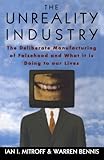The Unreality Industry
Material type: TextPublication details: Oxford University Press, IncorporatedDescription: 256 pagesISBN:
TextPublication details: Oxford University Press, IncorporatedDescription: 256 pagesISBN: - 9780195083989
| Item type | Current library | Call number | Copy number | Status | Date due | Barcode | |
|---|---|---|---|---|---|---|---|
 Book
Book
|
Lake Chapala Society | 306.09 MITR (Browse shelf(Opens below)) | 1 | Available | 41806 |
The claims made for television when it was a fledgling industry in the early 1950s have virtually all proven false. TV was to be the great entertainer-educator, an electronic marvel that could reach into the lives of millions and, over time, elevate their tastes and sensibilities. As we nowknow, of course, the entertainment component of this equation has so thoroughly dominated every aspect of TV and the mass media that most everything has been reduced to simple, slick, and powerful images. As Fred Friendly once remarked, "commercial television makes so much money doing its worst, itcan't afford to do its best." This is the state of things in America on the eve of the twenty-first century. And as Ian I. Mitroff and Warren Bennis show in this fascinating and profoundly disturbing book, the situation only promises to get worse. Already, newspapers and magazines such as USA Today and Business Week haveadopted a sort of television look, helping to blur the line between reality and fantasy that the authors believe is a frightening hallmark of contemporary life. Surveys show that up to 50% of those who watch crime re-enactment programs such as "Rescue 911" believe they are witnessing "the realthing." And consider, for example, the prospect of "virtual reality," where people can place themselves "inside" TV; in the not so distant future, the authors suggest, consenting adults will be able to slip into undergarments lined with sensors and miniature actuators and, while whisperingendearments, enjoy "sex" over the phone. What becomes clear as we read The Unreality Industry is that the deliberate creation of unreality is one of the most pivotal social forces shaping our time. Mitroff and Bennis explore in detail the pervasive and dangerous effects of television on American culture, arguing that we have fallen victim to the invented unrealities passed on through the mass media. Focusing on TV as the major culprit of a problem that threatens to spiral out of control,they point to specific issues such as the selection of political candidates, celebrity worship, and the choice by political and business leaders to offer the public pleasing visual images rather than real solutions to a variety of economic and social problems. The authors present a number ofsuggestions for corrective action, among them an impassioned plea for the uncommercialization of the television news, programs which continue to resemble more and more the satirical "game show" version of the news in the movie Network. The only book to address what is perhaps the most pressing social issue of our time, The Unreality Industry should be required reading for anyone concerned with the extent to which the "American Dream" has become just that.
There are no comments on this title.
